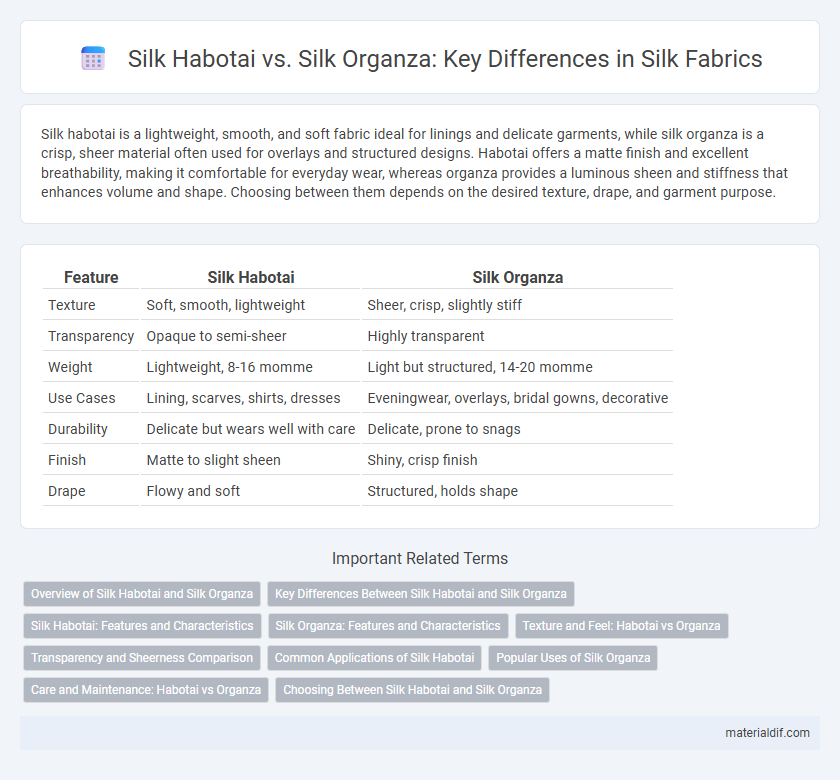Silk habotai is a lightweight, smooth, and soft fabric ideal for linings and delicate garments, while silk organza is a crisp, sheer material often used for overlays and structured designs. Habotai offers a matte finish and excellent breathability, making it comfortable for everyday wear, whereas organza provides a luminous sheen and stiffness that enhances volume and shape. Choosing between them depends on the desired texture, drape, and garment purpose.
Table of Comparison
| Feature | Silk Habotai | Silk Organza |
|---|---|---|
| Texture | Soft, smooth, lightweight | Sheer, crisp, slightly stiff |
| Transparency | Opaque to semi-sheer | Highly transparent |
| Weight | Lightweight, 8-16 momme | Light but structured, 14-20 momme |
| Use Cases | Lining, scarves, shirts, dresses | Eveningwear, overlays, bridal gowns, decorative |
| Durability | Delicate but wears well with care | Delicate, prone to snags |
| Finish | Matte to slight sheen | Shiny, crisp finish |
| Drape | Flowy and soft | Structured, holds shape |
Overview of Silk Habotai and Silk Organza
Silk Habotai is a lightweight, smooth, and soft plain weave silk known for its luxurious feel and excellent drape, commonly used in linings, scarves, and lightweight garments. Silk Organza is a sheer, crisp, and stiff fabric made with a plain weave, often utilized in evening wear, bridal gowns, and decorative overlays due to its structured transparency. Both fabrics originate from silk fibers but differ significantly in texture, weight, and application, making them distinct choices for different fashion and textile needs.
Key Differences Between Silk Habotai and Silk Organza
Silk Habotai is a lightweight, smooth, and soft fabric often used for linings and delicate garments, characterized by its tight weave and matte finish. In contrast, Silk Organza is a sheer, crisp fabric with a stiffer texture, commonly employed for overlays, bridal wear, and evening gowns due to its translucent and structured appearance. The key differences lie in their weight, texture, transparency, and typical applications, with Habotai providing softness and comfort while Organza offers volume and visual impact.
Silk Habotai: Features and Characteristics
Silk Habotai is a lightweight, smooth, and soft fabric made from finely woven silk fibers, often used for linings and delicate garments due to its breathable and comfortable qualities. It has a matte finish and a subtle sheen, making it ideal for applications requiring a natural, elegant drape without stiffness. Compared to Silk Organza, Habotai is less sheer and more flexible, providing a gentle texture that enhances comfort and wearability in fashion and interior designs.
Silk Organza: Features and Characteristics
Silk organza is a lightweight, sheer fabric known for its crisp texture and delicate translucency, often used in elegant eveningwear and bridal gowns. Its unique structure is created by a plain weave of fine silk threads, giving it a distinctive stiffness compared to softer silks like habotai. The fabric's ability to hold shape and volume makes it ideal for creating structured silhouettes and layering in high-fashion designs.
Texture and Feel: Habotai vs Organza
Silk Habotai features a smooth, soft texture with a lightweight, flowing feel that drapes elegantly, making it ideal for linings and delicate garments. Silk Organza offers a crisp, sheer texture with a stiffer hand, providing structure and volume in dresses and overlays. The contrast between Habotai's satin-like softness and Organza's translucent crispness highlights their distinct tactile qualities.
Transparency and Sheerness Comparison
Silk Habotai offers a smooth, lightweight texture with moderate transparency, making it ideal for linings and delicate garments that require subtle sheerness. Silk Organza features a crisp, stiff structure with high transparency, providing a more translucent and structured appearance for overlay or formalwear designs. The sheerness of Organza is significantly greater than Habotai, enhancing its use in garments requiring defined shapes and visible layering effects.
Common Applications of Silk Habotai
Silk habotai is widely used in lightweight linings, scarves, and delicate garments due to its smooth texture and soft drape, making it ideal for apparel that requires comfort and breathability. Unlike silk organza, which is stiffer and favored for structured shapes and decorative overlays, habotai excels in applications needing fluidity and subtle sheen. Its affordability compared to heavier silks makes it popular for everyday luxury items and costume linings.
Popular Uses of Silk Organza
Silk organza is popular for creating structured, voluminous bridal gowns and evening wear due to its crisp and lightweight texture. It is often used in overlays, ruffles, and decorative accents where sheerness and stiffness are desired. Its delicate transparency and ability to hold shape make it ideal for haute couture and special occasion garments.
Care and Maintenance: Habotai vs Organza
Silk habotai requires gentle hand washing with mild detergent and drying flat away from direct sunlight to maintain its soft texture, whereas silk organza demands more delicate care, often recommending dry cleaning to preserve its crisp, sheer structure. Habotai's fine weave is more prone to damage from harsh washing, while organza's stiffness can be compromised by improper handling or water exposure. Proper storage in a cool, dry place protects both fabrics, but organza benefits from being stored flat to avoid creasing, unlike the more resilient habotai.
Choosing Between Silk Habotai and Silk Organza
Silk Habotai features a smooth, lightweight texture perfect for delicate linings and soft drapery, while Silk Organza offers a crisp, sheer structure ideal for formal wear and bridal gowns. Choosing between Silk Habotai and Silk Organza depends on the desired garment's texture and visual effect: Habotai delivers a subtle sheen with fluid movement, whereas Organza provides a more structured, luminous appearance. Consider the fabric's weave density, weight, and transparency to align the material's characteristics with the intended design and wearability.
Silk habotai vs Silk organza Infographic

 materialdif.com
materialdif.com